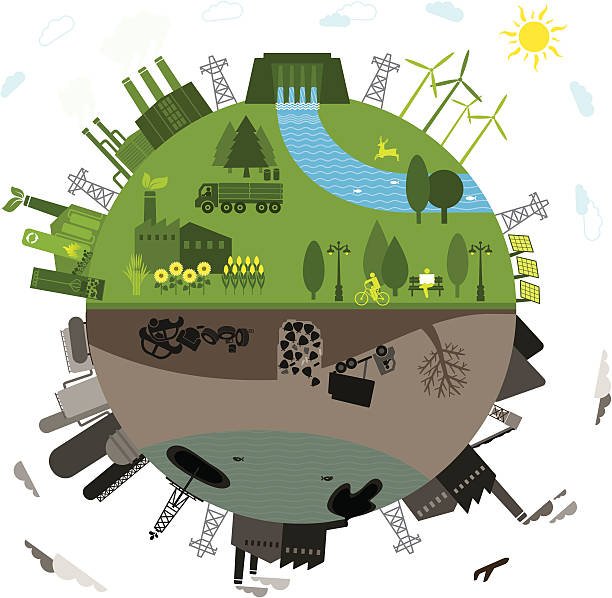Question: Describe four ways in which humans add carbon dioxide to the atmosphere.
Human activities have significantly contributed to the increase in carbon dioxide (CO2) levels in the atmosphere. Here are four ways in which humans add CO2 to the atmosphere:
Fossil Fuel Combustion
Explanation: One of the primary sources of human-caused CO2 emissions is the burning of fossil fuels like coal, oil, and natural gas. This happens in power plants, automobiles, airplanes, and industrial facilities.
Example for High School Students: Think of all the cars on the road. Every time they run, they’re burning gas and releasing CO2 into the air.
Deforestation
Explanation: When trees are cut down or burned, the carbon stored in them is released into the atmosphere as CO2. This happens on a large scale in activities like logging and land clearing for agriculture.
Example for High School Students: Imagine a forest like a big, green sponge that soaks up CO2. When you remove or burn down the trees, all that CO2 goes back into the air.
Industrial Processes
Explanation: Industries like cement production, chemical manufacturing, and metal smelting also contribute to CO2 emissions. These processes often involve chemical reactions that release CO2 as a byproduct.
Example for High School Students: Think about a factory making cement blocks. The process of turning raw materials into cement releases a lot of CO2.
Agriculture and Livestock Farming
Explanation: Agricultural activities, including the use of fertilizers and soil management, can release CO2. Moreover, livestock like cows produce methane, which is a potent greenhouse gas that eventually converts to CO2 in the atmosphere.
Example for High School Students: Think of a farm with lots of animals like cows. Their waste and even their burps add methane to the air, which eventually turns into CO2.
Each of these human activities has its unique impact, but collectively they contribute to the rising levels of CO2 in the atmosphere, which is a significant concern for global climate change.
Guide: How to Answer the Question “What are Four Ways Humans Add CO2 to the Atmosphere?”
If you’re a high school student looking to answer the question, “What are four ways humans add CO2 to the atmosphere?”, this guide will help you organize your thoughts, provide what to consider, and suggest theoretical frameworks that you can apply.
What to Consider
- Scale of Impact: Think about how widespread each method is. Is it something local, or is it a global issue?
- Direct vs Indirect Emissions: Some methods directly emit CO2, while others might contribute indirectly. Understand the difference between the two.
- Human Activities Involved: Identify the specific human activities that are responsible for each method of CO2 emission.
- Climate Change Impact: Think about how each method contributes to climate change and its global consequences.
Theoretical Frameworks
Systems Theory
You could use Systems Theory to discuss how different sectors (transportation, industry, agriculture, etc.) are interrelated components that contribute to the overall emissions of CO2.
Cause and Effect
Use the cause and effect framework to link human activities to their resulting CO2 emissions. This helps in explaining the direct consequence of each action.
Environmental Economics
This theory can help you explain how economic incentives, like cheaper fossil fuels or industrial growth, can be a driving force behind increased CO2 emissions.
Structuring the Answer
- Introduction: Briefly introduce the significance of the question by mentioning that human activities are major contributors to the increase in atmospheric CO2 levels, leading to climate change.
- Body:
- First Point: Discuss Fossil Fuel Combustion.
- Explain the process and scale.
- Apply Systems Theory to show how various sectors contribute.
- Second Point: Discuss Deforestation.
- Describe the activity and its scale.
- Use Cause and Effect to demonstrate its immediate and long-term impacts.
- Third Point: Talk about Industrial Processes.
- Explain what types of industries are involved.
- Use Environmental Economics to discuss economic incentives for such emissions.
- Fourth Point: Discuss Agriculture and Livestock Farming.
- Mention the activities involved like fertilizer use and livestock rearing.
- Apply Cause and Effect to demonstrate how these activities lead to CO2 emissions.
- First Point: Discuss Fossil Fuel Combustion.
- Conclusion: Summarize the four points, reiterate their significance, and mention the overall impact on climate change.
By following this guide, you will be able to give a comprehensive, well-structured answer. It will not only cover the required points but will also showcase your understanding of the theoretical frameworks that explain why these activities are such significant sources of CO2 emissions.






